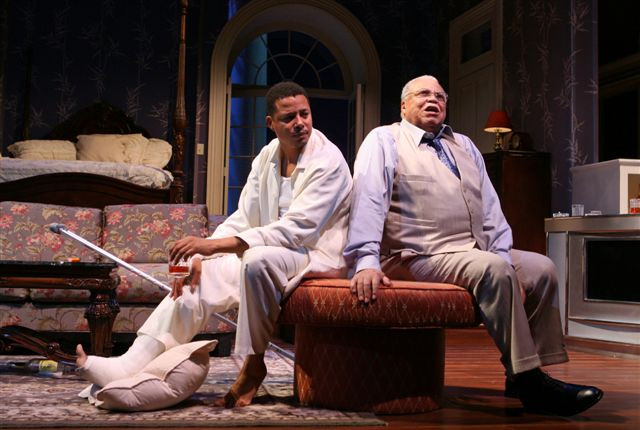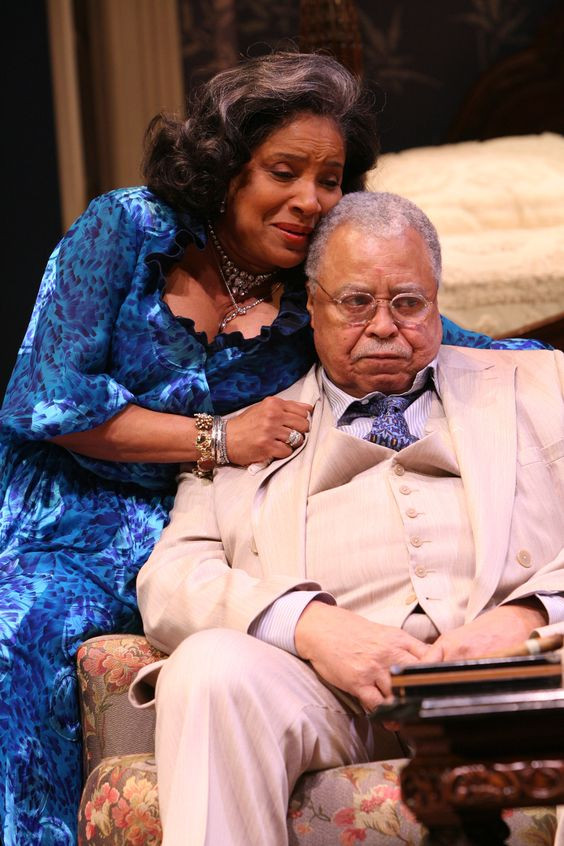Tennessee Williams’ Cat on a Hot Tin Roof is a powerful play, rich with complex themes and nuanced characters. Building on a previous discussion about the racial undercurrents within the play, this article delves into the 2008 Broadway revival featuring an all-black cast. Headlined by James Earl Jones and Phylicia Rashad, this production sparked considerable conversation, specifically around the concept of colorblind casting and its implications for a play so deeply rooted in the social and historical context of the American South. While the performances were undeniably strong, the decision to cast the play without regard to race raises pertinent questions about the interpretation and impact of Williams’ work.
 James Earl Jones as Big Daddy in the 2008 Broadway production of Cat on a Hot Tin Roof, questioning colorblind casting.
James Earl Jones as Big Daddy in the 2008 Broadway production of Cat on a Hot Tin Roof, questioning colorblind casting.
The casting of James Earl Jones as Big Daddy was particularly noteworthy. Jones himself expressed a long-held desire to play the iconic role. His gravitas and commanding presence certainly brought a unique dimension to Big Daddy, portraying the character’s mid-life crisis and confrontation with mortality with depth and power. However, this casting choice also invites a critical examination of how racial dynamics are perceived, or potentially overlooked, in such a production. The original context of Big Daddy’s wealth and power being derived from a Mississippi plantation in the early 20th century is inextricably linked to the exploitation of African American labor. Can these racial undertones be effectively addressed, or are they inevitably muted, when the entire cast is Black?
It’s crucial to acknowledge the historical complexities of race and land ownership in the American South. While it is true that some African Americans did own land and plantations, particularly within communities like the Cane River Creoles in Louisiana, this reality exists within a larger historical framework of systemic oppression and racial inequality. Cat on a Hot Tin Roof is set in Mississippi during the 1950s, a period marked by intense racial segregation and injustice, the same year as the tragic murder of Emmett Till and just before the burgeoning Civil Rights Movement. Placing a Black family in the position of the Pollitts, plantation owners in this era, necessitates a careful consideration of how race intersects with the play’s themes of power, inheritance, and social standing. Does an all-black cast illuminate or obscure these crucial historical and social realities?
Further complicating the discussion around colorblind casting is an incident that occurred around the same time as the Broadway revival, at Harvard University. When a production of Cat on a Hot Tin Roof at Harvard needed to replace an actor for the role of a servant – a character explicitly described as “a Negro servant” by Williams – the Harvard-Radcliffe Dramatic Club reached out to the Black Community and Student Theater (BlackCAST) for assistance. This outreach was met with concern by BlackCAST leadership. Their co-president, Andrew Coles, articulated the discomfort, stating, “What we immediately found worrisome is not that this is a black servant, but the fact that this is when we get recruited… That I found patently offensive, that this is the only time we have been called upon to help cast a role. It made me feel like I was the clearinghouse for black talent. What are we, 1-800-Cast-a-Negro?” This incident highlights the sensitivity surrounding casting decisions related to race and the potential for even well-intentioned colorblind casting to perpetuate problematic dynamics.
 Publicity image for the 2008 Broadway revival of Tennessee Williams' Cat on a Hot Tin Roof featuring the all-black cast.
Publicity image for the 2008 Broadway revival of Tennessee Williams' Cat on a Hot Tin Roof featuring the all-black cast.
Proponents of colorblind casting often argue that it emphasizes the universality of human experience, allowing audiences to connect with characters and themes on a deeper, more fundamental level, transcending racial boundaries. Indeed, the 2008 Broadway production of Cat on a Hot Tin Roof was praised by some for showcasing the universal themes of family conflict, desire, and mortality present in Williams’ play. However, critics like playwright Douglas Turner Ward have countered this perspective, arguing that while universal themes exist, they are always embedded within specific social and historical contexts. Ward stated, “Williams may not be overtly talking about the social environment and the context, but it is there . . . That play is not taking place in an abstract universe. It’s Mississippi in a particular time in history. Big Daddy exists because of living on the backs of people’s labor.”
Echoing this sentiment, the esteemed playwright August Wilson, in a 1996 speech at Princeton University, voiced strong reservations about colorblind casting, particularly when applied to plays that are deeply rooted in specific cultural experiences. Wilson argued that casting Black actors in roles originally conceived for white actors, in plays exploring “white culture,” can inadvertently deny Black artists their own cultural specificity and history. He asserted that it is crucial for Black artists to investigate the human condition “from the cultural ground on which we stand as black Americans.” Wilson’s perspective challenges the notion that colorblind casting is always a progressive or neutral act, suggesting it can sometimes obscure or even erase important cultural narratives.
While there are instances where colorblind casting can be incredibly effective, enriching a play and offering fresh perspectives – consider a multicultural cast in Shakespeare’s A Midsummer Night’s Dream – its application to plays like Cat on a Hot Tin Roof demands careful consideration. How does the play’s meaning shift when race is intentionally removed from the casting equation in a story so deeply entwined with racial history? To illustrate further, imagining a white actor in the lead role of Brutus Jones in Eugene O’Neill’s The Emperor Jones, or a white family in Lorraine Hansberry’s A Raisin in the Sun, reveals how fundamentally casting choices can alter a play’s core themes and social commentary. While universal human themes might still resonate, the crucial social milieu that informs the characters’ experiences would be significantly diminished.
Ultimately, the discussion around the 2008 all-black cast of Cat on a Hot Tin Roof highlights the complexities of colorblind casting. While it undoubtedly provided a platform for incredibly talented Black actors to tackle iconic roles, it also compels us to question whether such casting truly serves the play’s deeper meanings and historical context, or if it inadvertently mutes crucial social undercurrents. The effectiveness and appropriateness of colorblind casting remain a subject of ongoing debate, particularly when applied to works that are inherently linked to issues of race and identity.

